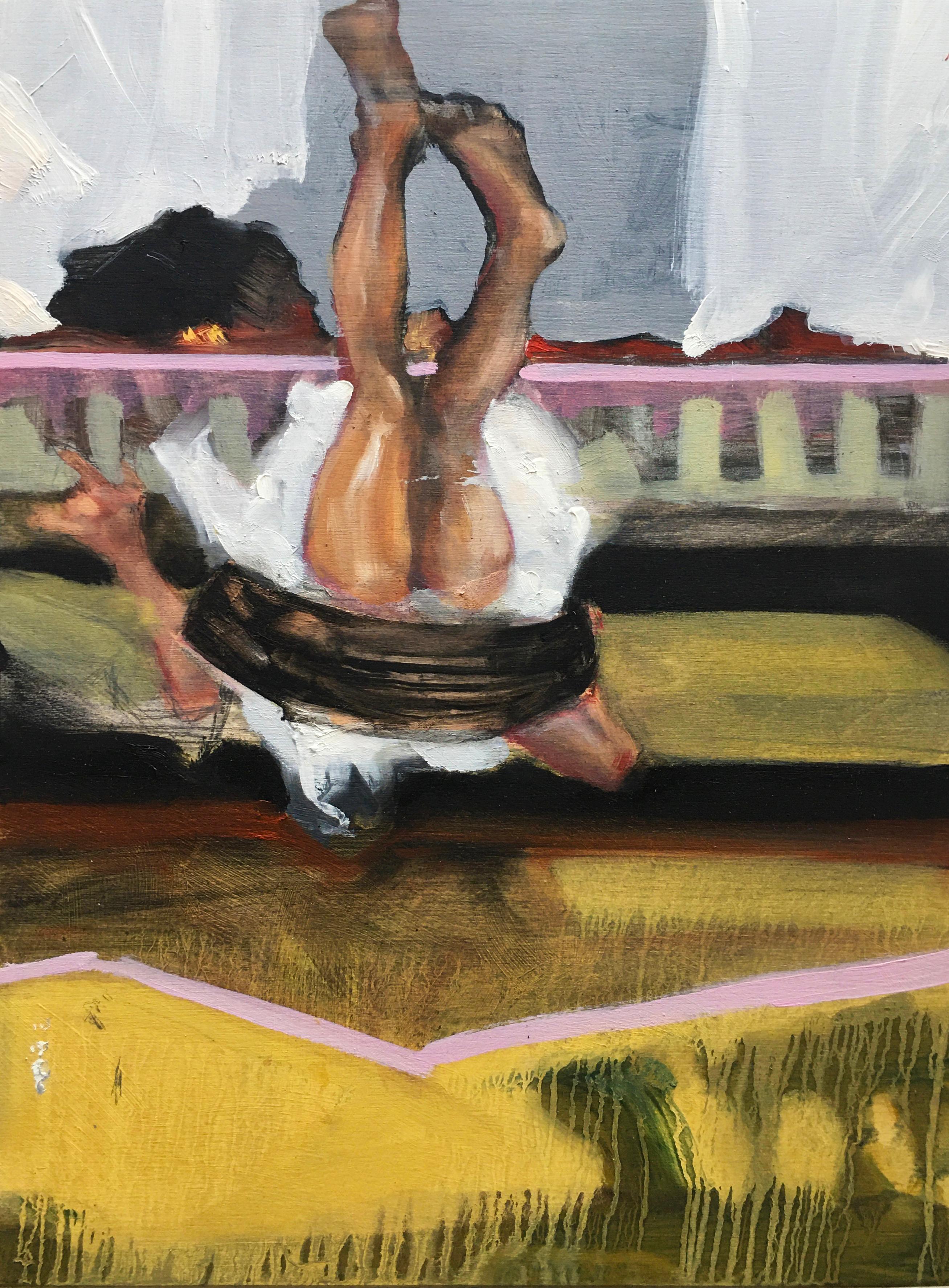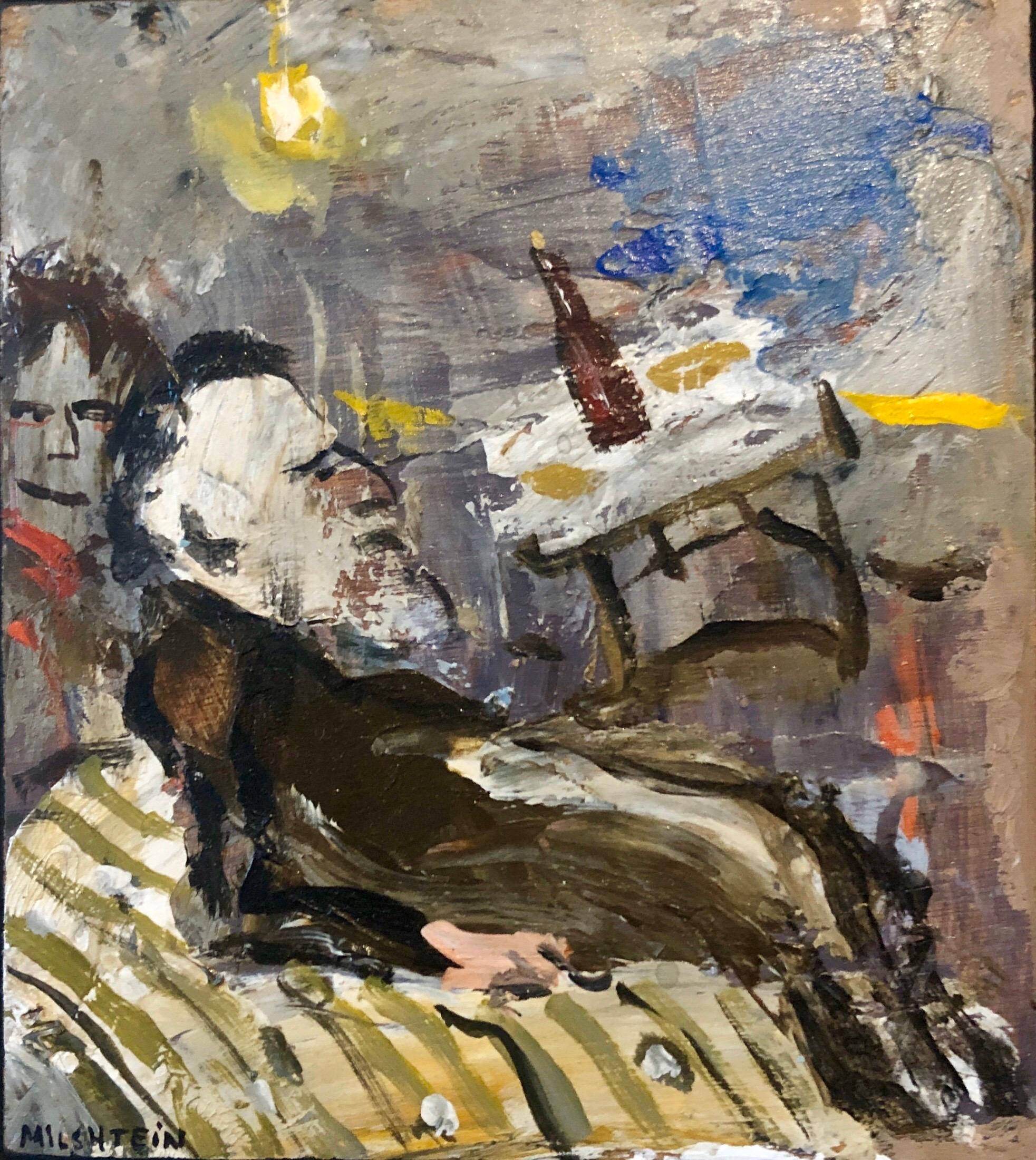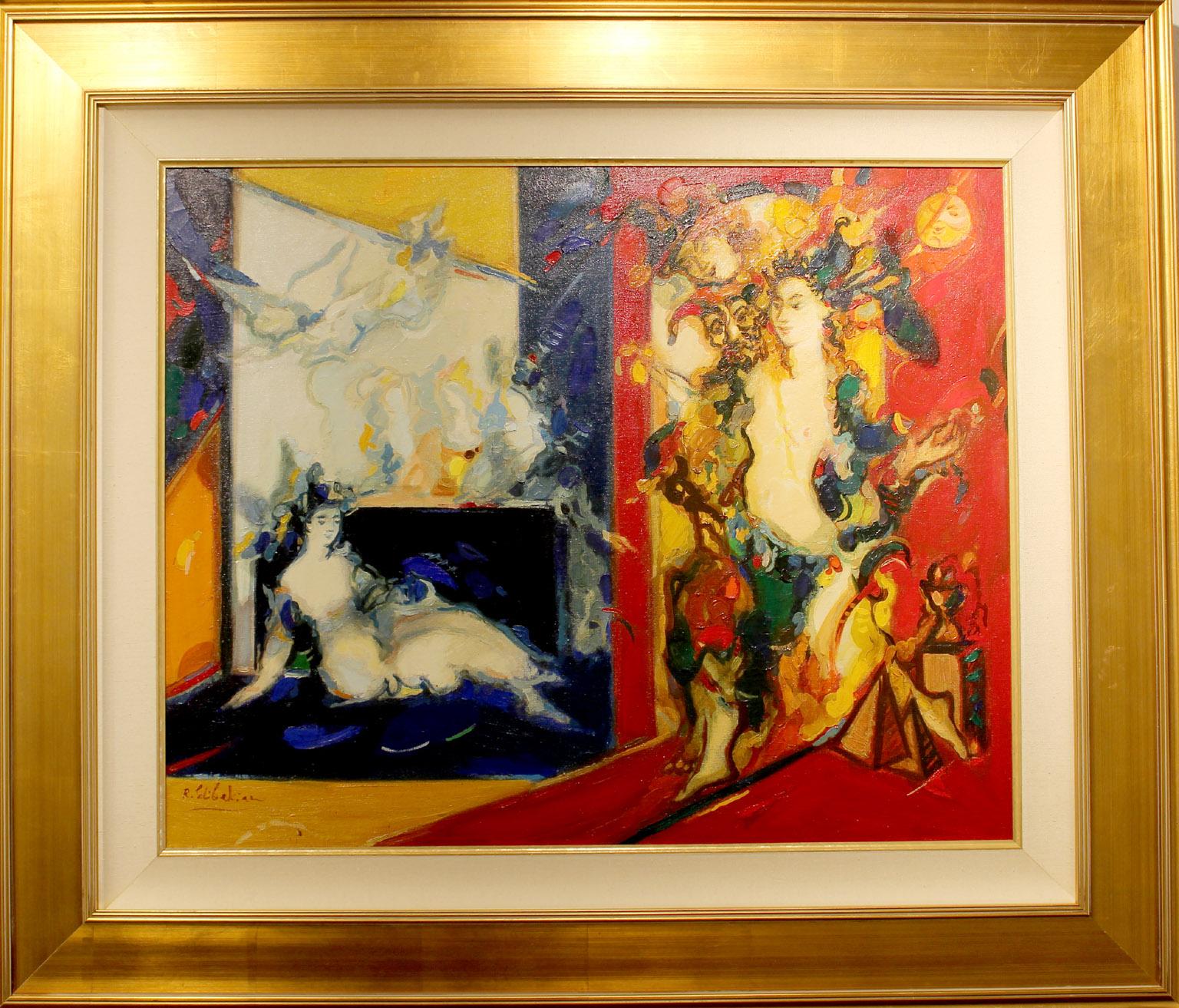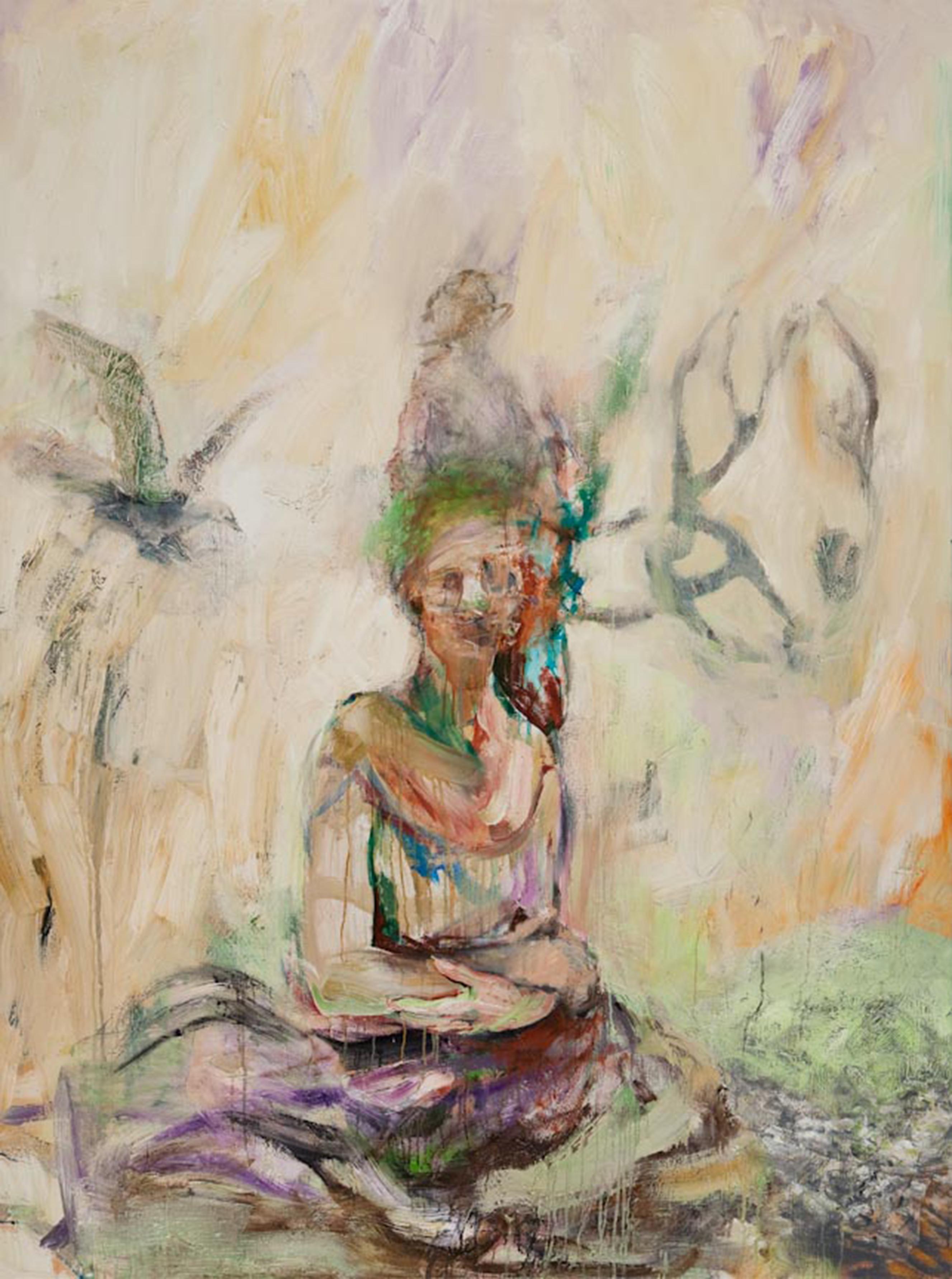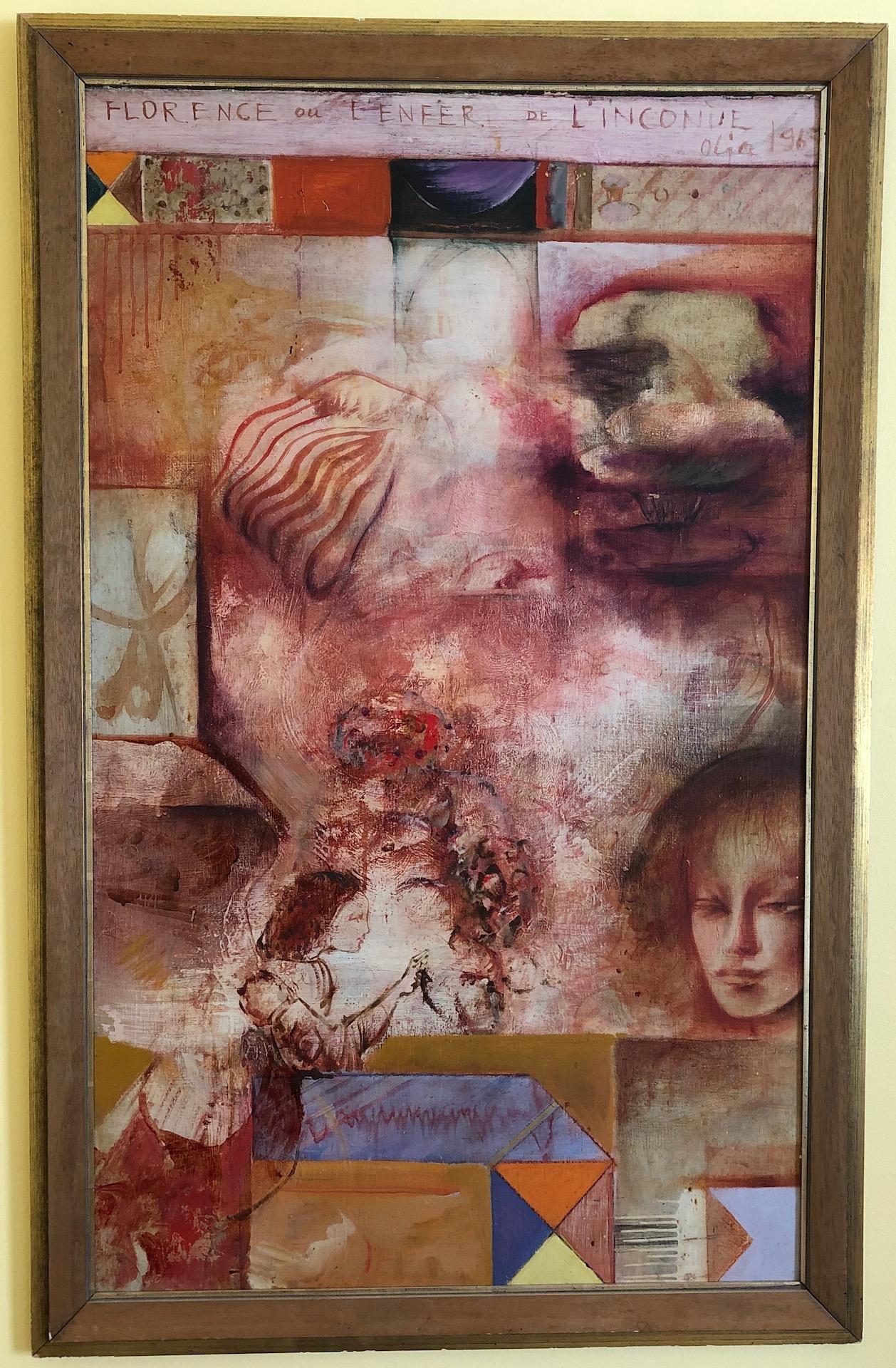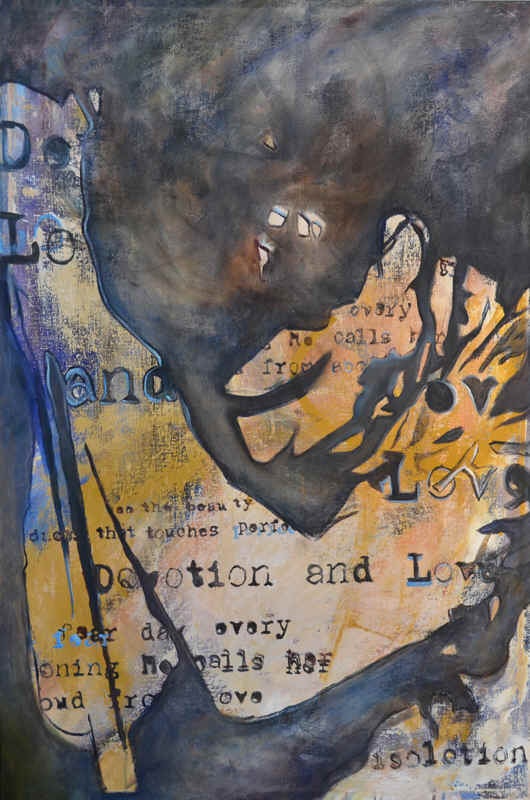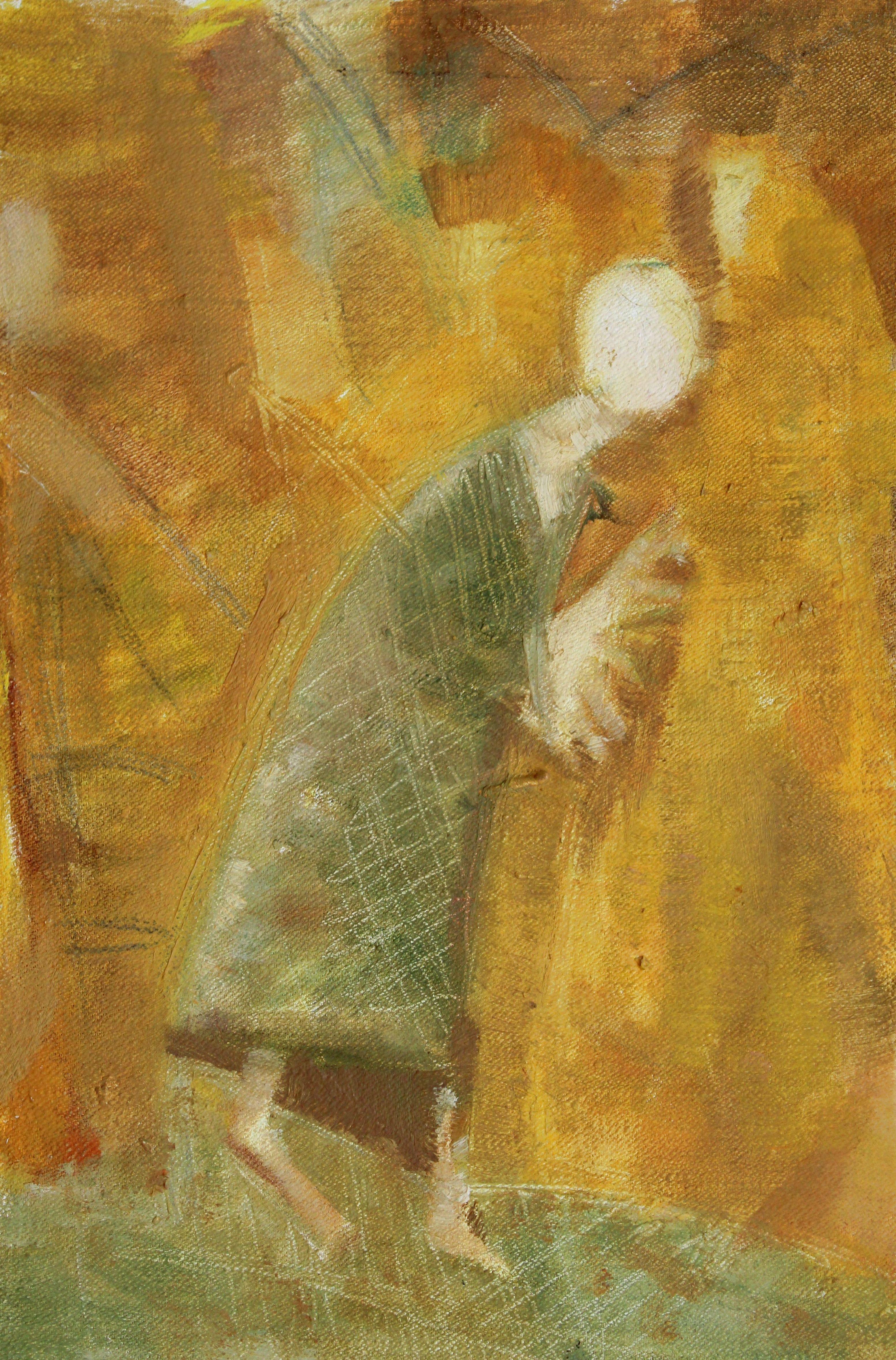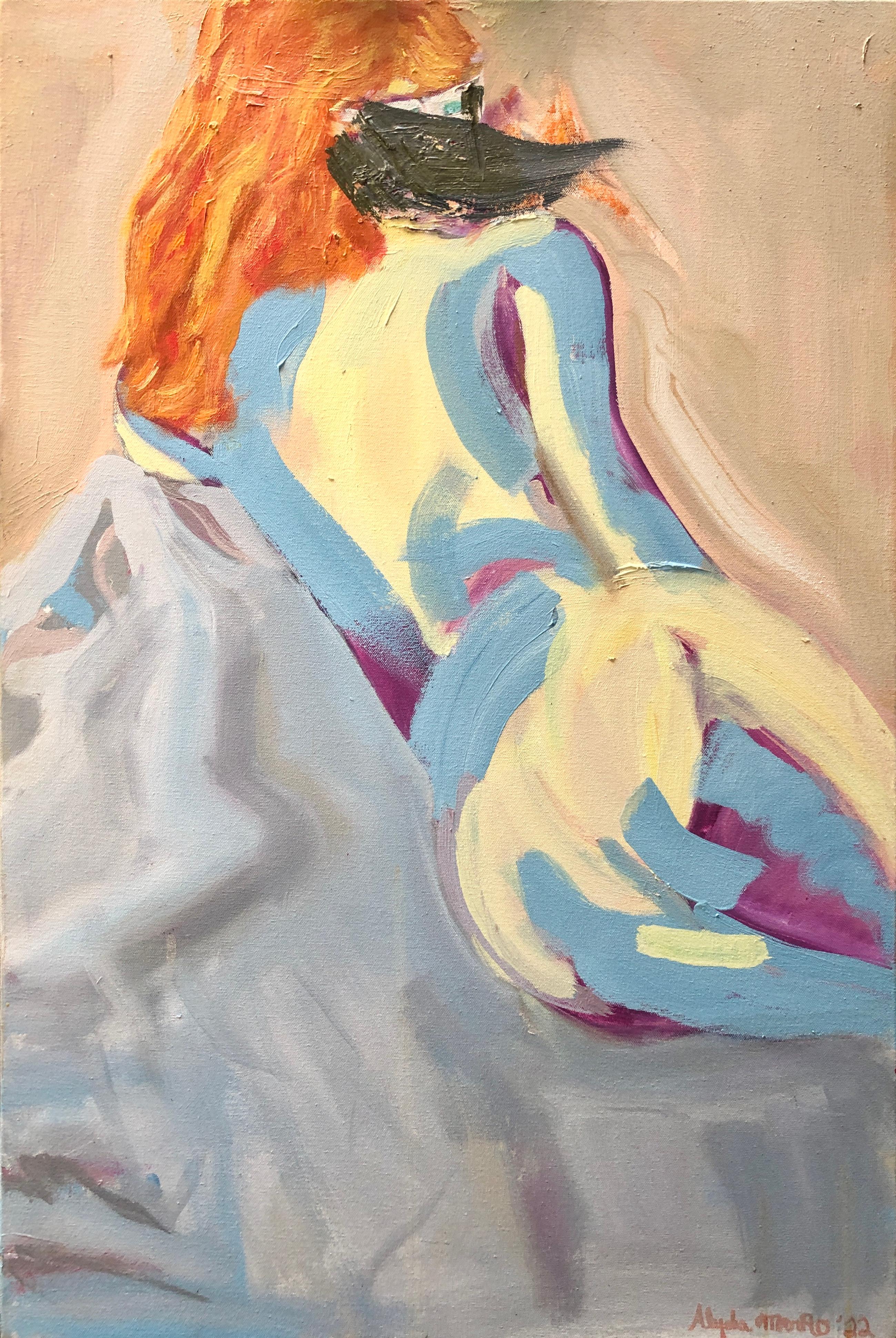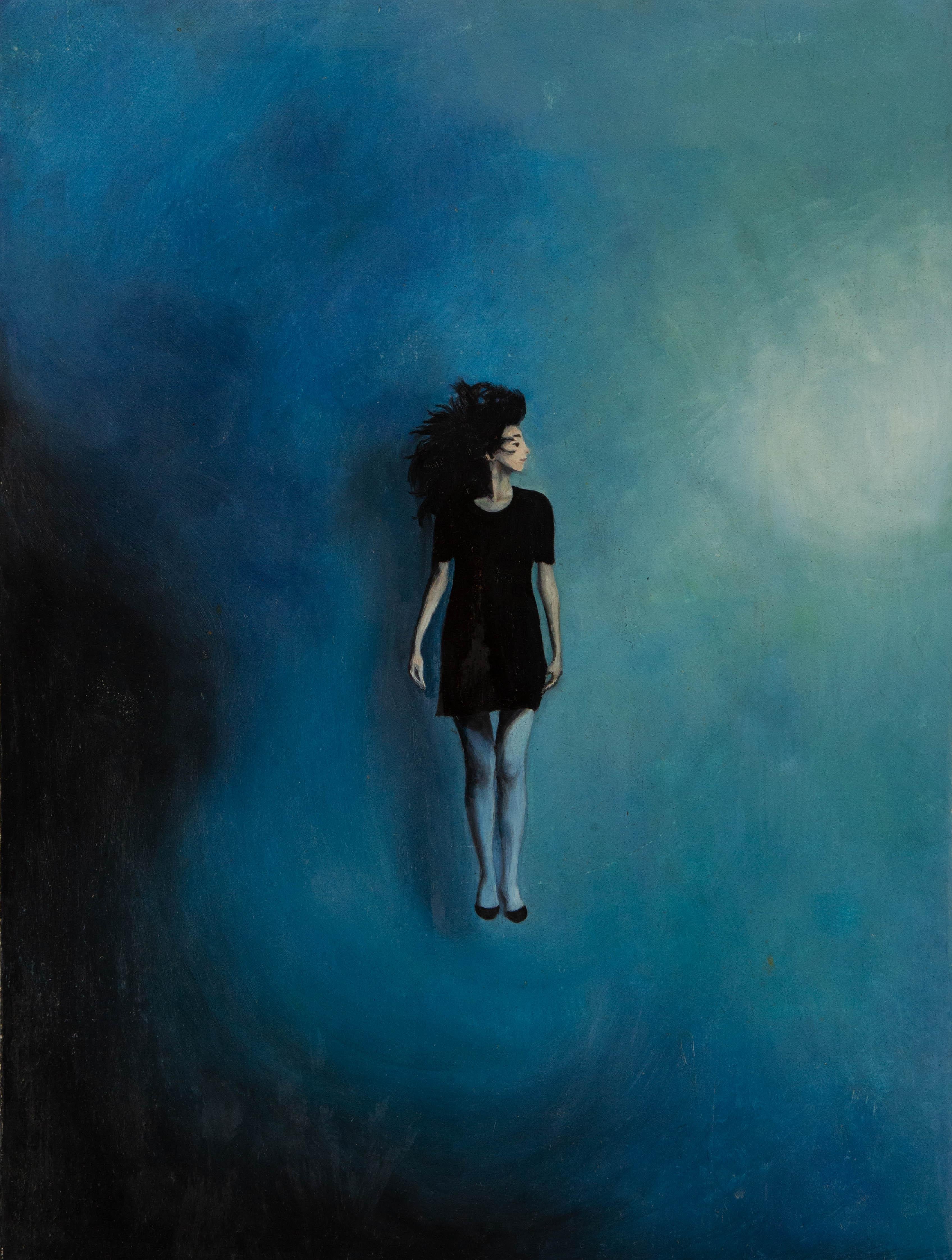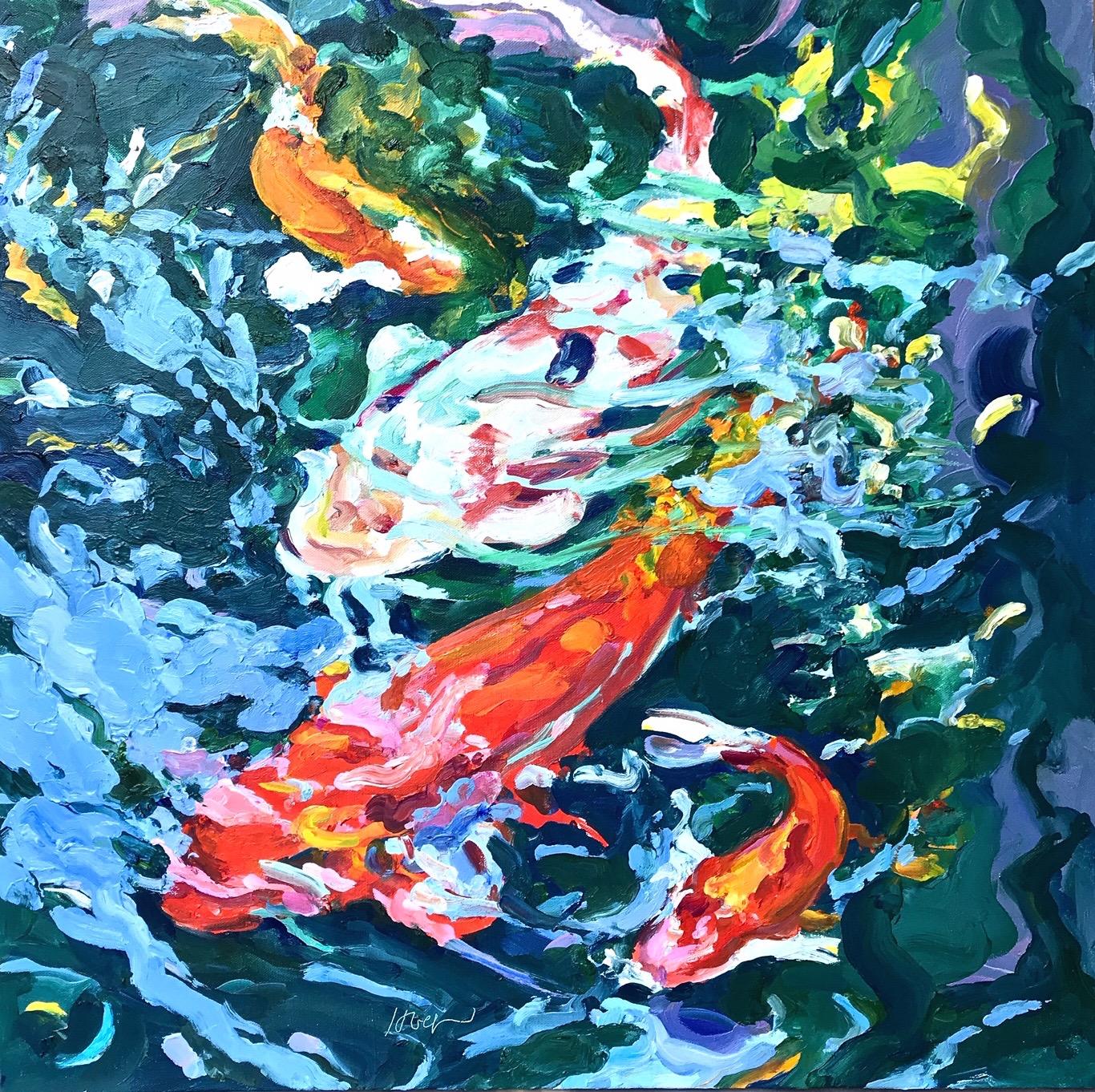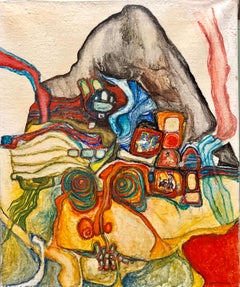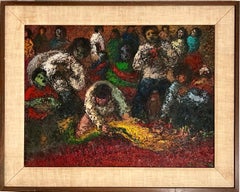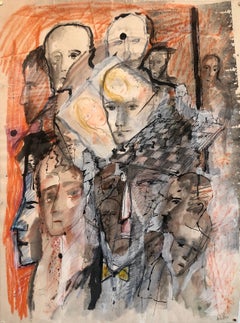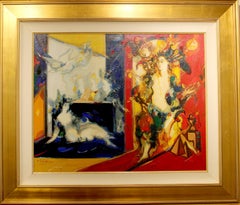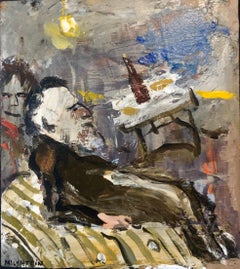
French Israeli Surrealist Judaica Jewish Oil Painting Rabbi at Table, Bottle
Want more images or videos?
Request additional images or videos from the seller
1 of 10
Zvi MilshteinFrench Israeli Surrealist Judaica Jewish Oil Painting Rabbi at Table, Bottlec.1960s
c.1960s
$1,800List Price
About the Item
- Creator:Zvi Milshtein (1934, French, Russian)
- Creation Year:c.1960s
- Dimensions:Height: 15.5 in (39.37 cm)Width: 14.5 in (36.83 cm)
- Medium:
- Movement & Style:
- Period:
- Condition:good. frame has some wear.
- Gallery Location:Surfside, FL
- Reference Number:1stDibs: LU3825478182
About the Seller
4.9
Platinum Seller
Premium sellers with a 4.7+ rating and 24-hour response times
Established in 1995
1stDibs seller since 2014
1,784 sales on 1stDibs
Authenticity Guarantee
In the unlikely event there’s an issue with an item’s authenticity, contact us within 1 year for a full refund. DetailsMoney-Back Guarantee
If your item is not as described, is damaged in transit, or does not arrive, contact us within 7 days for a full refund. Details24-Hour Cancellation
You have a 24-hour grace period in which to reconsider your purchase, with no questions asked.Vetted Professional Sellers
Our world-class sellers must adhere to strict standards for service and quality, maintaining the integrity of our listings.Price-Match Guarantee
If you find that a seller listed the same item for a lower price elsewhere, we’ll match it.Trusted Global Delivery
Our best-in-class carrier network provides specialized shipping options worldwide, including custom delivery.More From This Seller
View AllFrench Israeli Surrealist Judaica Jewish Oil Painting Rabbi at Table, Bottle
By Zvi Milshtein
Located in Surfside, FL
This is a small oil painting on on panel. A Rabbi at a Farbrengen
15.5 X 14.5 with frame.
6.5 X 5.5 painting alone
Zwy Milshtein (Zvi Tzvi Milstein) BIOGRAPHY 1934 Born in Kishinev...
Category
20th Century Expressionist Figurative Paintings
Materials
Oil, Panel
French Jewish Post Holocaust Abstract Painting Manner of Hundertwasser Art Brut
By Jichak Pressburger
Located in Surfside, FL
Jichak Pressburger, Painter. b. 1933, Bratislava, Czechoslovakia. A concentration camp survivior. Came to Israel aboard the ship, "The Exodus". 1964 Went to Paris. In 1979 Returned as new immigrant.
Education Tel Aviv University, B.A. in art, with Marcel Janco and Isidor Ascheim at Avni art school.
Beaux Arts, Paris with Professor Coutaud.
Itzchak Pressburger
Stays in Paris from 1963 – 1979, Resident of the “Cité des Arts” 1969-1972. Lives and works in Jerusalem since 1979.
One-Man Exhibitions
1963 Gallery Dugit, Tel-Aviv
1968 Cultural Center Enkhuizen, Netherlands
1968 Gallery Zunini, Paris (chosen by the art critic of « Opus : Jean-Jacques Lévèque)
1970 Gallery Zunini, Paris
1973 Gallery Maitre Albert, Paris. Cultural Center Verfeil sur Seye, France
1974 Gallery Maitre Albert, Paris
1976 Gallery Mundo, Barcelone
1980 Artists’ House, Jerusalem
1981 Gallery Alain Gerard, Paris
Group Exhibitions
1966 Rathaus Charlottenburg, Berlin. (The first show of Israeli painters in Germany
Artists Center of Silvarouvres, Nantes, Ffance
XXXth Salon of Finances at “l’Hotel des Monnaies”, Paris
1969 Maison de Culture, Le Havre, France
1968 Gallery Zunini, Paris (chosen by the art critic of « Opus : Jean-Jacques Lévèque)
Salon « Grands et Jeunes d’Aujourd’hui », Paris
Museum of Fine Arts, Nantes, France
Cultural Center Vitry, France
Gallery Il Giorno, Milan
Cité des Arts, Paris
1972 Salon “Grands et Jeunes d’Aujourd’hui”, Paris
Salon de Mai, Paris
1973 Städtische Galerie, Siegen, Germany
1974 Jewish Cultural Center, Paris
Publicis, Paris
1975 Réalitiés Nouvelles, Paris
1976 Salon de Mai, Paris
1977 “Perspectives Israeliennes”, Grand Palais, Paris
1981 Salon Alain Gerard, Paris
1984 Artists’ House, Jerusalem
Publication
1990 Haggadah Yom Kippour (Hebrew/French) Abraham Bliah (private edition), Paris
Acquisitions
1968 The City of Paris
1972 The State of France
The Yitzchak Pressburger artist was born in Bratislava – known for centuries by its German name of Pressburg – but the outbreak of World War II found him and his family in Prague. His father realized they had to escape from the Nazi occupiers and tried to get the family across the border into Hungary. However, they were caught near the crossing point, arrested and incarcerated overnight at the nearby railway station. The Czechs put them on a train to Hungary early the next morning. That was their first miracle in their quest for survival.
They survived with relative ease until late 1943, when the father was taken away to a forced labor camp. He subsequently died in a death march. Things became even more precarious in early 1944, when the Holocaust made its full-blown presence felt in Hungary.
“It wasn’t the Germans, it was the Hungarian Nazis who did the dirty work,” Pressburger points out. The family lived in so-called “safe houses” that were protected by Switzerland, Finland and Sweden. The havens were dismantled in late 1944, and the Pressburgers moved into one of the two Jewish ghettos in Budapest. The Nazis had found two houses with Jews, including the one where we had been, and took them all out and shot them next to the Danube. Today there is a monument by the river [called Shoes on the Danube Bank]. We should have been with the Jews who were killed by the river,” he says.
After the war, Pressburger and his siblings were farmed out to various orphanages run by the Jewish Agency, and things took a decidedly better turn.
“We finally had food to eat,” he recalls. “After a while we were put on trains that were protected by the Jewish Brigade [of the British Army], and we were sent to Austria, and then to Germany.”
“My uncle was a famous artist, and I learned a lot from him,” he says. While in Germany, Pressburger also took some lessons with a local artist.
His mother managed to get him and two of his siblings berths on the Exodus, which set sail from Marseilles for Palestine in July 1947. Pressburger was 13 at the time and clearly recalls the aborted attempt to get to the Promised Land.
“It was so crowded on the boat. This was a ship that was made to ply rivers in the United States, with a few hundred people on board, and we had over 4,500 passengers crammed in.”
As we know, the British prevented the Exodus from docking in Palestine, and the passengers were shipped – in three far more seaworthy vessels – back to France. After the French government refused to cooperate with the British, Pressburger and the others found themselves back in Germany. The teenager eventually made it here in 1948, just one month before the Declaration of Independence.
After a short furlough in Tel Aviv, during the first lull in the fighting in the War of Independence, he moved to Kibbutz Kfar Ruppin, where he worked in the cowshed. All the while he continued feverishly drawing and honing his artistic skills, which he says came in handy when he joined the IDF.
After completing his military service, which included a spell as one of the founding members of the Flotilla 13 naval commando unit, he worked in Sdom for a while at the Dead Sea Works before starting his formal arts training in earnest.
I was in the first group of students at the Avni Institute [in Tel Aviv],” he says. “There was quite a famous bunch of students and teachers like Moshe Mokadi and Isidore Ascheim and Aaron Giladi.”
In such illustrious company, one might have thought Pressburger was set to unleash his burgeoning talents on art connoisseurs across the globe, but it was a while before that happened.
Pressburger arrived in the French capital in 1964 and spent close to 15 years there, with a short interlude in Germany, before returning to Israel. His time in Paris was a professionally rewarding period of his life, and he also found love.
“[Avni Institute teacher] Yochanan Simon gave me the name and address of a French-Israeli family in Paris, but when I got to the house, a young woman opened the door and told me the family was on vacation in Israel,” he explains. Despite missing his expected hosts’ welcome, he and the German-born young lady who greeted him soon fell for each other, and romance quickly led to wedding bells. By all accounts, Pressburger did well in Europe. He secured a rare three-year berth at Cité Internationale des Arts, where artists are normally provided with accommodation and studio space for between two months and a year. He was also accepted to the prestigious Beaux Arts academy of fine arts, mounted solo exhibitions, and took part in group shows all over Europe.
One of these last was a group exhibition at Rathaus Charlottenburg in Berlin in 1966 – the first exhibition of Israeli artists in Germany after the Holocaust. When he arrived in Berlin, the lineup for the Israeli show was already signed and sealed, but somehow his work came to the attention of the German culture minister, who arranged for him to join. The Pressburgers’ year-long sojourn came to an abrupt end following an encounter he had one day while walking through the crowded Berlin streets...
Category
1960s Expressionist Abstract Paintings
Materials
Canvas, Oil
Peruvian Expressionist Oil Painting Miguel Aybar Modernist Latin American Art
Located in Surfside, FL
Dimensions: (Frame) H 28.5" x W 35.5" (Painting) H 22" x W 30"
Miguel Ángel Aybar Llauca, an artist specializing in expressionist painting, was born in Huancavelica and lives in the city of Ica where he began drawing from a very young age, drawing from its beautiful valleys and customs. In 1970 he began his studies in Drawing, Painting and Sculpture at the Regional School of Ica. He is a graduate of the National Superior Autonomous School of Fine Arts of Peru (1971-1976) with honorable mention, forming the promotion "Juan Manuel Ugarte Eléspuru".
"Iqueño Expressionism" is the title of the exhibition that will be available to the public from May 25 to June 13 in the "Paracas" Room of the "Adolfo Bermúdez Jenkins" Regional Museum of Ica. Av. Ayabaca block 8°.
Miguel Angel Aybar is a painter who characterizes expressionism in Ica without a doubt. His songs speak of longing, and secret friendships with the hurango, the palm tree of Huacachina or the silent and still sand of Ica. His work is primarily characterized by color. The contrasts between the intense dark contrasted with the radiance of reds, oranges, yellows or greens, achieve a positive effect on the observer. Its warm tones reach high levels like an Ica sun at noon. However, among those quasi Servulian colors , Andean prints maintain their presence. Hats, ponchos or skirts hidden from a root bound by blood or memories.
The perfect textures of his works give him the seal, the personality that characterizes a curdled and experienced Aybar who no longer needs to dialogue with the brush; they just flow, hand and brush. When entering the exhibition hall, you do not need to read the signature, he is an Aybar. There is no room for confusion. Although there are not a few artists from Ica who use these boiling tones, and I translate it as a tribute to that Sérvulo that touches you in the depths of your being, if you are an artist and you live in Ica, you want to be possessed by the ghost of the disturbing Sérvulo Gutiérrez turned legend. Servulus still catches the spectator being absorbed, as if observing a volcano, fearing that it might erupt, but with an inexplicable delight that he stops you next to him and captures you.
However, Aybar no longer needs Servulo's shadow, he has gained an important space in the artistic world of Ica. He is an artist and a close friend of poets and musicians. Painter recognized by the Ica society and deserving of all the medals and recognitions by the different institutions. He not only paints with mastery, as Alberto Dávila predicted, when he said that his maturity would give him the position that corresponds to him. He now sings in public to the delight of his closest friends. Ica recognizes him as a son and has given him the place that corresponds to this remarkable painter whom I congratulate.
DATA ABOUT THE ARTIST
Miguel Angel Aybar Yauca, was born in 1952 in Huancavelica. He has lived in Ica since he was very young; he began his art studies at the Ica Regional School of Fine Arts. He later moved to Lima to study at the National Autonomous School of Fine Arts of Peru from where he graduated in 1976.
His teacher Alberto Dávila described him as: a restless, imaginative young man with a sober and dramatic color. His forms acquire poise and great eloquence . Aybar also had the painter Carlos Aitor Castillo...
Category
20th Century Expressionist Figurative Paintings
Materials
Canvas, Oil
Chess Game Set French Israeli Surrealist Watercolor Gouache Painting
By Zvi Milshtein
Located in Surfside, FL
This is a large hand signed mixed media paiting on Arches French paper. A chess game encounter. Figurative Abstract Expressionist painting.
Zwy Milshtein (Zvi Tzvi Milstein) BIOGRA...
Category
20th Century Expressionist Figurative Paintings
Materials
Mixed Media, Watercolor, Gouache
Oil Painting Abstract Contemporary Art Zachary Armstrong Portraits After Noah
Located in Surfside, FL
ZACHARY ARMSTRONG (American, Born 1984 in Dayton, Ohio)
Portraits after Noah Green & Grey
Oil on paper, 2016, with label from Tilton Gallery, NY. ve...
Category
2010s Contemporary Abstract Paintings
Materials
Paper, Oil
Judy Rifka, Abstract Expressionist Oil Painting on Paper Hockey Players
By Judy Rifka
Located in Surfside, FL
Judy Rifka (American, b. 1945) "Ice Hockey"
Acrylic or oil paint on Fabriano paper paintings featuring multiple hockey players executed in yellow, white, purple, and black hues.
Ha...
Category
1980s Pop Art Abstract Paintings
Materials
Oil
You May Also Like
"Man Overboard", oil painting, figurative, man, woman, bikini, recline, gaze
Located in Toronto, Ontario
"Man Overboard" is an oil painting with chalk and graphite on wood panel, and measures 16" high by 12" wide. It is finished with a clear resin across the surface, lending the artwork a particular warmth and liquidity that is rare and lovely to behold. Typical of the artist, the painting is a mystery despite its apparent simplicity – a woman wearing part of her bikini stretches out beside a pool or body of water, while another figure hovers nearby. The title Man Overboard would suggest the woman's pose and partial nudity have completely derailed the man's intentions – perhaps driven him to distraction. Note the restrained color palette, the subtle toning of the wood surface, the bodies rendered and bodies suggested. The surface is very interesting – drawn lines and painterly brushstrokes to be sure, but also the toned wood coming through as color and texture. All of it held, as if in time, by the resin layer acting as a lens to both transmit this picture and admit light to the picture. A true artifact.
From Will Hudson...
Category
21st Century and Contemporary Expressionist Figurative Paintings
Materials
Resin, Chalk, Oil, Wood Panel, Graphite
"Strange Angel", oil painting, figurative, guardian, wings, spirit, orange, gold
Located in Toronto, Ontario
"Strange Angel" is an oil painting with chalk and graphite on wood panel, and measures 12" high by 12" wide. It is finished with a clear resin across the surface, lending the artwork a particular warmth and liquidity that is rare and lovely to behold. Typical of the artist, the painting is a mystery despite its apparent simplicity – possibly a winged creature or person in the presence of another person. Note the restrained color palette, the subtle toning of the wood surface, the bodies rendered and bodies suggested. The surface is very interesting – drawn lines and painterly brushstrokes to be sure, but also the toned wood coming through as color and texture. All of it held, as if in time, by the resin layer acting as a lens to both transmit this picture and admit light to the picture. A true artifact.
From Will Hudson...
Category
21st Century and Contemporary Expressionist Figurative Paintings
Materials
Resin, Chalk, Oil, Wood Panel, Graphite
"Swing", oil painting, figurative, play, barefoot, yard, upside down, legs
Located in Toronto, Ontario
"Swing" is an oil painting with chalk and graphite on wood panel, and measures 16" high by 12" wide. It is finished with a clear resin across the surface, lending the artwork a particular warmth and liquidity that is rare and lovely to behold. Typical of the artist, the painting is a mystery despite its apparent simplicity – a girl or young lady on a swing...
Category
21st Century and Contemporary Expressionist Figurative Paintings
Materials
Resin, Chalk, Oil, Wood Panel, Graphite
Spectacle, year 2002, 26"x32" oil on canvas, framed size 36x42 in.
By Robert Elibekyan
Located in La Canada Flintridge, CA
The painting sizes are 26x32 in. with framed sizes are 36x42 inches.
The composition from Mysterious Theater series, Robert Elibekian specialized in ...
Category
2010s Expressionist Abstract Paintings
Materials
Oil
Giulia (The Good Mother)
Located in Santa Monica, CA
Oil on Canvas
Category
21st Century and Contemporary Expressionist Figurative Paintings
Materials
Oil
Olja Ivanjicki "Florence or Hell of l'Inconnue De La Seine" Oil Painting c.1965
Located in San Francisco, CA
Olja Ivanjicki "Florence or Hell of l'Inconnue De La Seine" original oil circa 1965
Original oil on board. Dimensions 26" wide x 42" high.
The frame measures 30" wide x 46" high.
Signed and dated at the upper border. She has auction results over $9,000 which was earlier in 2021.
Olga Ivanjicki, the daughter of Russian emigrants was born in Pancevo, Danube Banovina. She studied at the Academy of Fine Arts in Belgrade, graduated in 1957, and in the same year she was the only woman among the founders of MEDIALA Belgrade, an art group of painters, writers and architects such as Leonid Šejka, Vladimir Velickovic, Ljubomir Popovic, Miodrag Ðuric. In 1962, she received a scholarship of the Ford Foundation to pursue her art studies in the United States, and in 1978 she was a selected artist of the Fulbright program Artist in Residence at the Rhode Island School of Design.
She had over ninety individual exhibitions and participated in numerous national and international group exhibitions. Ivanjicki’s painting was influenced by Symbolism, Surrealism, Pop art and Fantastic art. In the course of her career, the artist received the Vuk Lifetime Achievement Award (Vukova nagrada, 1988), the Seventh of July Award (Sedmojulska nagrada, 1988) and the Karic Award.
L'Inconnue de la Seine (English: The Unknown Woman of the...
Category
Mid-20th Century Expressionist Abstract Paintings
Materials
Oil
